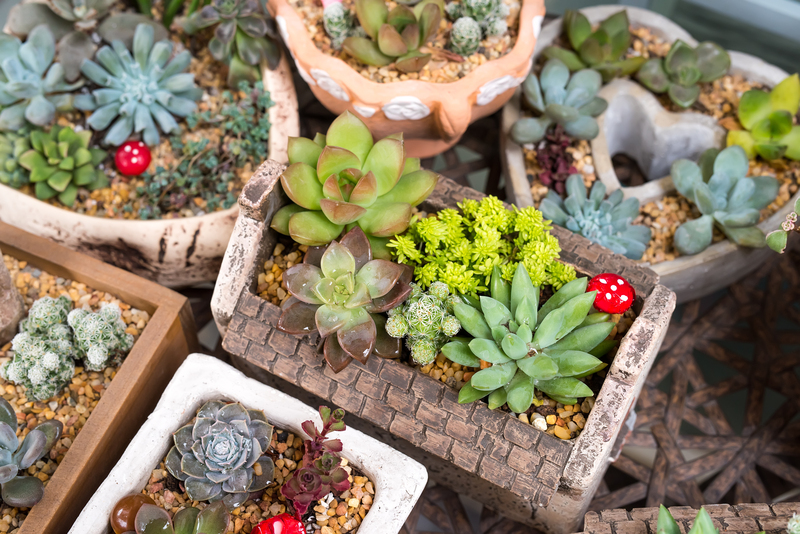5 Simple Solutions for a Thrifty, Low Maintenance Garden
Posted on 28/05/2025
5 Simple Solutions for a Thrifty, Low Maintenance Garden
Are you dreaming of a beautiful outdoor space but dread the thought of endless upkeep or hefty expenses? Creating a garden that's both cost-effective and easy to manage is not just a wish--it's well within your reach. Whether you're a seasoned green thumb or a complete beginner, these thrifty, low maintenance garden ideas will help you grow glorious green spaces with less work and less money.

Why Choose a Thrifty, Low Maintenance Garden?
Gardening can enhance your home's beauty, boost mental wellbeing, and even improve your property's value. However, the prospect of regular garden chores, high water bills, and pricey plants can be overwhelming. That's where a low maintenance garden shines, offering you all the joys of a lush outdoor sanctuary without draining your wallet or your free time. Here's why making your garden low-maintenance and budget-friendly is a smart decision:
- Save Money: Spend less on plants, water, and supplies.
- Save Time: Enjoy more time relaxing, less time maintaining.
- Conserve Resources: Water, fertilizers, and energy use are minimized.
- Boost Sustainability: Native and drought-tolerant plants foster local wildlife and pollinators.
- Increase Enjoyment: Focus your energy on appreciating your space, not endless chores.
1. Embrace Easy-Care Plants for Effortless Beauty
The foundation of any thrifty, low maintenance garden is selecting plants that thrive with minimal intervention. Forget about high-maintenance lawns or delicate flowers that demand constant TLC--instead, choose robust, fuss-free varieties that are naturally suited to your local climate and soil conditions.
Choose Native and Drought-Tolerant Varieties
- Native plants: These species are adapted to your region's weather and pests, so they require less water, fertilizer, and care. Examples: Black-eyed Susan, Coneflower, Milkweed (in North America), Lavender and Thyme in Mediterranean climates.
- Succulents and cacti: Perfect for hot, dry climates and can even thrive in containers or rock gardens.
- Ornamental grasses: Add movement, texture, and need only occasional trimming.
- Groundcovers: Plants like Creeping Jenny or Ajuga can suppress weeds and require little mowing or pruning.
Start Small & Propagate for More Savings
Begin with a modest selection of tough plants, and multiply them for free by dividing or taking cuttings in future seasons. Not only does this save money, but it also helps your garden look fuller over time.
- Division: Many perennials, like daylilies, can be split into several new plants every couple of years.
- Cuttings: Rooting tips or stems in water or soil gives you new plants for zero cost.
2. Minimize Weeds and Watering With Smart Mulching
A secret weapon of the savvy gardener, mulching offers a multitude of benefits. By covering the soil with an organic or inorganic material, you can dramatically reduce weeds, lock in moisture, and even nourish your plants--all while saving money.
Why Mulching Is Essential for a Low Maintenance Garden
- Suppresses Weeds: Blocks sunlight, making it harder for weeds to emerge.
- Retains Soil Moisture: Reduces evaporation, so you water less often.
- Improves Soil Quality: Organic mulches break down over time, adding beneficial nutrients.
- Regulates Temperature: Protects roots from temperature extremes.
Thrifty Mulch Options
You don't need to splurge on fancy bark chips. Consider these economical mulch choices:
- Grass clippings: Let your lawn feed your garden--spread thin layers to avoid matting.
- Shredded leaves: In autumn, bag and use leaves as nutrient-rich mulch.
- Newspaper or cardboard: Use as an underlayer to further suppress weeds (just avoid glossy, colored prints).
- Pine needles: Free from many tree-lined properties, excellent for acid-loving plants.
Not only does mulching reduce your workload, but it also supports a healthier, thriving garden that requires fewer interventions throughout the year.
3. Design Easy-Care Beds and Borders
The physical layout of your garden can make a dramatic difference in how much effort it takes to maintain. Thoughtful design leads to smoother mowing, less weeding, and a more attractive, organized appearance.
Tips for a Low Maintenance Garden Layout
- Define clear shapes: Use curves or geometric shapes for your beds--they're easier to mow and maintain than intricate, irregular designs.
- Group plants by needs: Cluster plants with similar water and sunlight requirements to streamline maintenance.
- Choose raised beds or containers: These reduce weed pressure, improve drainage, and can be filled with the ideal soil blend for your chosen plants.
- Opt for wider beds: Fewer, larger planting areas require less edging and create more visual impact.
Edging for Effortless Upkeep
A solid garden edge not only adds polish but prevents grass and weeds from invading beds. Use bricks, stones, metal, or recycled materials for a low-cost, long-lasting border. You'll spend less time digging and more time enjoying your thrifty, low maintenance garden.
4. Cut Watering Costs With Smart Irrigation and Rain Harvesting
A major component of low maintenance gardening is water conservation. Traditional lawns and flowerbeds can gulp up gallons of water, especially during hot months. Cut costs and effort with these drought-wise strategies:
Install a Simple, Efficient Watering System
- Drip irrigation: This affordable system directs water right to the plant's roots, minimizing waste and discouraging weeds.
- Soaker hoses: Easy to weave through beds, these hoses ensure deep, efficient watering and minimize evaporation.
- Timers: Set and forget--a basic water timer automates your irrigation, so you'll never over or underwater.
Harvest Free Rainwater
Why pay for water when nature provides it for free? Collecting rainwater is environmentally responsible and can provide all the water your low maintenance garden needs, even during dry spells.
- Rain barrels: Place one at the end of your home's downspout to capture gallons of water for your beds and pots.
- DIY collection: Large, cleaned containers or re-purposed drums can do the trick for less money.
Make sure all containers have a tight-fitting lid to deter mosquitoes, and check local regulations regarding rainwater harvesting.
5. Choose Practical, Attractive Ground Cover Alternatives
Traditional lawns are costly and time-consuming, requiring regular mowing, fertilizing, and watering. By swapping some or all of your grass for low maintenance ground covers, you unlock a thrifty, low-effort landscaping solution.
Replace Grass With Evergreen or Flowering Ground Covers
- Creeping thyme: Fragrant, purple-blooming, and tough enough to handle foot traffic.
- Clover: Stays green, requires little mowing, and fixes nitrogen in the soil--reducing the need for fertilizer.
- Moss: Perfect for shady, damp spots where grass struggles.
- Sweet woodruff, vinca, and bugleweed: Quick to spread and suppress weeds effectively.
Other Lawn-Free Landscaping Ideas
- Gravel, pebbles, or bark chips: Inexpensive, long-lasting, and eliminate mowing.
- Patios and paths using recycled pavers or stepping stones: Reduce garden space to maintain and add functionality.
- Edible landscaping: Incorporate berry bushes, herbs, or dwarf fruit trees for beauty and homegrown harvests.
Extra Tips for an Effortless, Budget-Friendly Garden
- Compost: Create your own rich soil enhancer from kitchen scraps and garden clippings--totally free and eco-friendly.
- Grow from seed: Seeds are vastly more affordable than mature plants, especially for annuals and vegetables.
- Repurpose: Upcycle old containers, pallets, or tires as planters or garden decor.
- Buy at plant sales: Local botanical gardens and clubs often have great deals on hardy plants for your area.
- Plan for the long-term: Invest in perennials and slow growers that get better (not needier) with age.

Designing Your Own Thrifty, Low Maintenance Garden: Step by Step
Ready to put these ideas into action? Here's a simple process for transforming any space into a stunning, thrifty low maintenance garden:
- Evaluate your site: Note the basic conditions--sun, shade, soil, drainage, and space you want to devote to gardening.
- Decide on a simple layout: Sketch out a rough plan using curves, defined beds, and open paths for easy movement.
- Select tough, adaptable plants: Research what grows with little care in your local area--focus on native species and groundcovers.
- Mulch and edge: After planting, blanket beds with mulch and use practical edging to keep everything tidy.
- Set up watering solutions: Install drip irrigation, soaker hoses, or arrange your rain barrels before the dry season starts.
- Add personal touches: Repurpose materials for paths, create DIY garden art, or build a simple bench from found wood.
Conclusion: Enjoy a Beautiful, Relaxing Garden--For Less
A thrifty, low maintenance garden is one that serves you, not the other way around. By choosing straightforward designs, easy-care plants, sustainable practices, and budget-friendly strategies, you'll create an outdoor haven that's a joy to use and a breeze to maintain. Not only will you save money and effort, but you'll also do your part for the environment and have more time to simply enjoy your landscape.
With a little planning and these 5 simple solutions, you can transform your space--no matter the size--into a stunning, sustainable, and affordable retreat. Nature does most of the hard work; you need only guide it along!
So go ahead: start small, think smart, and grow big savings in your own backyard with these practical low maintenance gardening tips.



